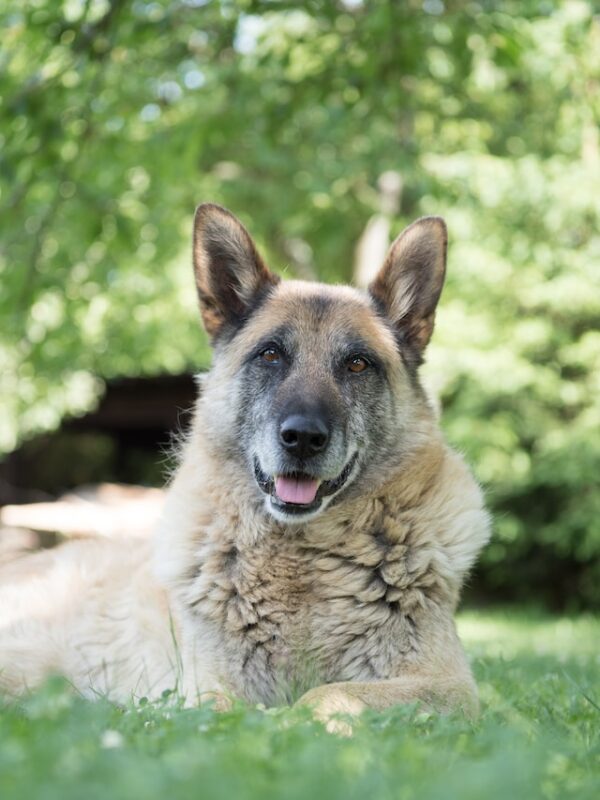Bone Cancer in Dogs: Symptoms, Causes and Treatment
Posted: 04/22/2024 | BY: Jenna Bruce | Categories: Dog , Health problems , Pet care
It is always heartbreaking when a beloved pup receives a diagnosis of cancer. Bone cancer in dogs is quite common and, while any dog breed can develop bone cancer, it often affects large or giant breeds.
In this blog post we’ll cover some of the common symptoms of bone cancer, causes of the disease, as well as some treatment options.

Symptoms of Bone Cancer in Dogs
The development of bone cancer in dogs is quite complex, but it is thought to have a genetic component. It is generally diagnosed between the ages of 6 and 8, though vets have diagnosed it in dogs as young as 6 months old.
Because bone cancer typically affects the limbs, most dogs show signs of lameness. Other symptoms may include:
- Soft tissue swelling
- A palpable mass
- Limb asymmetry—one limb larger or abnormal looking in comparison
- Decreased appetite
- Pain in the limbs when touched or when walking
- Tachycardia (elevated heart rate)
- Dehydration
- Neurologic signs
Causes of Bone Cancer in Dogs
When it comes to the development of bone cancer in our pups, there seems to be a definite hereditary factor involved. And large or giant breeds have the most risk. Researchers have identified the following breeds to have a particularly high genetic risk factor for bone cancer:
- Scottish Deerhounds
- Rottweilers
- Greyhounds
- Irish Wolfhounds
While genetic predisposition increases risk, bone cancer can also form in previously injured bones, such as:
- Radiation therapy sites
- Previously healed fractures
- Chronic osteomyelitis (bone infection)
Treating Canine Bone Cancer
Sadly, the long-term prognosis for bone cancer in dogs is poor. Upon diagnosis, most vets will determine what stage the cancer is based on the presence of distant cancer spread. This will help your vet determine your pup’s specific prognosis and the right course of treatment, if any is possible.
Treatment for bone cancer typically involves:
Surgery
Your vet may find it to be beneficial to have the primary bone tumor removed. This may entail amputating the entire limb in some cases. While dramatic, it is a common procedure and usually well tolerated by dogs, who can learn to live quite well with only three legs. If the tumor is elsewhere your dog may need to have a rib or jaw bone removed.
Chemotherapy
Chemotherapy is often used to prolong a pup’s life, though just how long is always hard to determine. Common chemotherapy agents used these days for bone cancer are cisplatin, carboplati or doxorubicin.
Immunotherapy
Immunotherapy is a developing field in both human health and canine health. It is the process of using the body’s own immune system to treat cancer.
Palliative Care
For those pups who are not good candidates for surgery or chemotherapy, there are treatment options to help ease pain and potentially increase survival time. Some treatments include radiation therapy and aggressive pain management.

Does Pet Insurance Cover Cancer Care?
Yes, pet insurance typically covers cancer care, but with some key points to consider:
- Accident and Illness Plans: These plans generally cover cancer diagnosis and treatment.
- Pre-Existing Conditions: No pet insurance covers pre-existing conditions, so your pet’s cancer needs to be diagnosed after the policy starts.
- Plan Details: The extent of coverage (tests, treatments, etc.) varies depending on the specific plan you choose. Some plans may offer cancer as an add-on rider.
- Accident-Only Plans: These plans won’t cover cancer because it’s an illness.
Here are some tips on choosing an insurance plan that will cover cancer treatments:
- Enroll your pet in pet insurance early, ideally when they’re young and healthy.
- Carefully review plan details and exclusions regarding cancer coverage.
- Ask your pet insurance provider any questions you have about cancer care coverage.
Cancer is a major expense for pet owners, and pet insurance can be a lifesaver financially. Be sure to compare plans and understand the coverage details before enrolling.
References:
- Tuohy JL, Shaevitz MH, Garrett LD, et al. Demographic characteristics, site and phylogenetic distribution of dogs with appendicular osteosarcoma: 744 dogs (2000-2015). PLoS One 2019;14(12)
- Ehrhart EP, Christensen NI, Fan TM, et al. Tumors of the Skeletal System. Withrow & MacEwen’s Small Animal Clinical Oncology, Elsevier. 6th ed.; 2020: 524-64.
- Boston SE, Ehrhart NP, Dernell WS et al. Evaluation of survival time in dogs with stage III osteosarcoma that undergo treatment: 90 cases (1985-2004). J Am Vet Med Assoc. 2006; 228:1905-8.
Disclaimer
The information contained on this blog is intended for informational and educational purposes only and should not be construed as medical advice. It is not a substitute for professional veterinary care. Always consult with your veterinarian before making any changes to your pet's health care or treatment plan.
The authors of this blog are not veterinarians and do not claim to be experts in pet health. The information provided here is based on our own experiences and research, as well as information from reputable sources. However, we cannot guarantee the accuracy or completeness of this information.
We encourage you to do your own research and consult with your veterinarian before making any decisions about your pet's health.
Previous post
Why Do Cats Lick You?Next post
Pet Insurance for DachshundsCompare top pet insurance providers plans.
Enter your dog’s age in years and months to calculate their age equivalent to human years.
Calculate your dog’s ageEnter your cat’s age in years and months to calculate their age equivalent to human years.
Calculate your cat’s age
